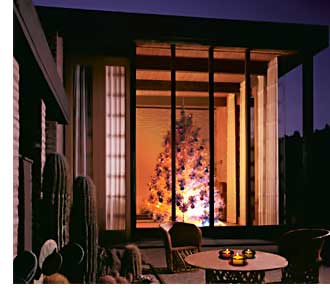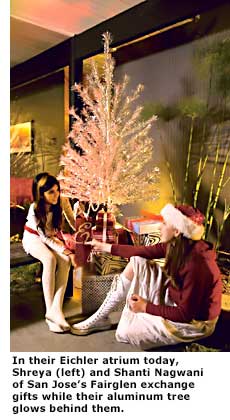Shimmering Nostalgia: The Aluminum Christmas Tree

They shimmer and spin. They entice and satisfy. And these days, after years of near extinction, aluminum Christmas trees are back in the limelight, beloved by mid-century modern aficionados as the ultimate in holiday décor.
Once derisively called 'tin Tannenbaums,' aluminum Christmas trees provoked or infuriated many people when they first hit the market in 1959—but entranced so many others.
Jerry Waak, a sales manager for the Aluminum Specialty Company, the outfit that first mass-produced the silver-needled tinsel trees, recalls typical reactions. "People would laugh," recalls Waak. "Some people would say, 'You're kidding!' A lot of people said they would never sell. Some people would just about throw you out of their store."
But that wasn't what young Bill Yaryan thought about the aluminum tree his parents set up in their furniture store in the early 1960s. He'd sit on the floor and watch the silver tree rotate on its stand while the color wheel revolved as well in a kind of crazy dance.

"When the color wheel and tree were rotating, the effect was so wonderful and so totally artificial," says Yaryan, who lives in a modern Alexander home in the San Fernando Valley. "Tree, 'snow,' and ornaments would change in blazing unison to red, green, and blue, as the tree and wheel spun endlessly. It was completely unhinged from any other Christmas decorations in use then. Its space-age novelty was great."
Over the past few years, aluminum trees have made a comeback, and nowhere more so than in mid-century modern homes, where they just seem so—at home. What could be more eye-on-the-future, after all, or—dare we say it?—greener, than an aluminum Christmas tree?
"Aluminum," Gary Gand observes, "was the material that was going to save the earth back in the '50s. When we were kids, aluminum foil was just the greatest stuff. And aluminum cars."
"They are one of the great icons of the time," says Gand, who lives in an Alexander tract home in Palm Springs and in a Keck-and-Keck modernist home near Chicago, "like the boomerang, the Formica kitchen table top, and the TV dinner."
Unlike 'real' trees—but really, how is wood any 'realer' than aluminum?—the aluminum sort never drop their needles. "All the kitsch but no sticky pitch," is how Scot Nicholls, who lives in a San Jose Eichler, puts it. "There's no mess involved. Christmas goes up—and Christmas goes down and into a box, and it's gone. It's pretty easy."
And Gand, who insists against some evidence to the contrary that mid-century modern homes "are incredible green-friendly" thanks to passive solar design and compact plans, says that aluminum trees complete the environmentally friendly package.
"There's some astronomical number of Christmas trees that get thrown out every year. It's like 100 million trees every year. But people don't pay attention to it—because it's Christmas," he says. "The beauty of the aluminum tree, if you're a green person, it's the same tree over and over again for 50 years."
"The aluminum tree seemed to symbolize a new birth in technology, a better, more rational way of living," Julie Lindemann and John Shimon wrote in 'Season's Gleamings: The Art of the Aluminum Christmas Tree' (Melcher Media, 2004), their book that ignited the aluminum tree craze. They concluded: "The modernist Christmas had arrived."
Dave Peterson, who owns a San Jose Eichler home, sensed the modernist appeal of aluminum trees even when he was a boy living in his parents' 1870s Victorian home in Wisconsin—not far, coincidentally, from Manitowoc, where Aluminum Specialty manufactured its trees. Peterson's mother filled their home with precious antiques, and their Christmas was highly traditional.
But young Dave coveted his neighbor's Christmas. "The lady across the street from us had an aluminum tree in her picture window, and I thought it was the coolest thing ever."
"It's the rotating lights along with the chrome," he says. "Think about Cadillac bumpers—the chrome '50s."
But if 1950s modernism was all about rational planning and efficiency, then the aluminum tree transcends its genre—just as that other icon of the '50s, the flying saucer, transcends the U-2, not to mention anything flown by Pan Am. Lindemann and Shimon, who began their foray into aluminum mania by collecting as many Aluminum Specialty trees as they could find and arraying them, forest-like, in their art studio, picked up on this early.





